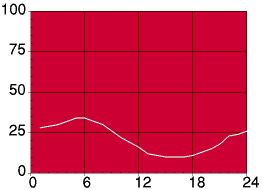Imagine a room, 3m x 4m x 2.5m say (volume 30m2).
Imagine that this room is perfectly sealed from the outside. ie
- No air can enter or leave
- No heat can enter or leave through the structure
The room is at 35oC and the air is completely dry.

| More tablespoons of water can be added to the room, each reducing the temperature by 1oC upon evaporation. | |||
 | |||
| Similarly, at other starting temperatures, the result would be the same. | |||
 | |||
| Thus, by saturating dry air at 35oC in a room completely 'heat sealed' the temperature will drop to 12.4oC. ie by 22.6oC. | |||
| Dry: 35oC Wet: 12.4oC Drop: 22.6oC Dry: 40oC Wet: 14.3oC Drop: 25.7oC |  | ||
| Other saturation points may be added for other lines of constant enthalpy. | |||
 | |||
| Continuing by marking in each quarter value of specific humidity. | |||
 | |||
| Joining up the points and we now have a, though incomplete, moderately useful Psychrometric Chart. | |||||
 | Remember the scale on the Vertical Lines IS linear. The Scale on the slanted lines IS NOT linear. | ||||
| Cooling Potential | |||
| A 100% efficient cooler could convert this air: | |||
 |  | ||
| Into this air: | |||
 |  | ||
| Direct Evaporative Cooling: Cunningham/Thompson Tower | |||
Air enters through top of tower. Air takes on moisture and descends tower. Flow enhanced by addition of solar chimney. |  | ||